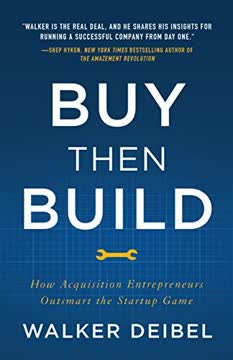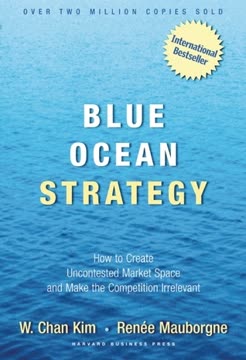Key Takeaways
1. Marketing and sales must align for business success
When sales are disappointing, Marketing blames the sales force for its poor execution of an otherwise brilliant rollout plan. The sales team, in turn, claims that Marketing sets prices too high and uses too much of the budget, which instead should go toward hiring more salespeople or paying the sales reps higher commissions.
Misalignment hurts performance. When marketing and sales departments are out of sync, it negatively impacts corporate performance. This disconnect can lead to longer sales cycles, higher market-entry costs, and increased cost of sales.
Benefits of alignment. Conversely, when marketing and sales work well together, companies see substantial improvements in key performance metrics:
- Shorter sales cycles
- Lower market-entry costs
- Reduced cost of sales
Case study: IBM's success. IBM demonstrated the power of integration by creating a new function called Channel Enablement, which combined sales and marketing groups. This integration addressed several issues:
- Salespeople focused on fulfilling product demand rather than creating it
- Marketers failed to link advertising spending to actual sales
- Poor coordination led to ill-timed product announcements
By aligning these departments, IBM was able to capitalize on marketing efforts and improve overall performance.
2. Understanding the evolving marketing-sales relationship
As companies become larger and more successful, executives recognize that there is more to marketing than setting the four P's: product, pricing, place, and promotion.
Marketing's evolving role. As businesses grow, the nature of the marketing function changes significantly:
-
Small businesses:
- No formal marketing group
- Marketing ideas come from managers, sales force, or advertising agencies
- Marketing equated with selling
-
Growing businesses:
- Add marketing personnel to support sales force
- Marketers conduct research, choose markets, and develop collateral materials
- Marketing seen as an adjunct to sales
-
Larger companies:
- Marketing becomes an independent player
- Focuses on segmentation, targeting, and positioning
- Competes with sales for funding
Shifting dynamics. This evolution can lead to disagreements between sales and marketing, as their missions diverge. Salespeople may want marketers to focus on long-term strategy, while marketers begin to work more closely with other departments like Strategic Planning and Product Development.
3. Overcoming economic and cultural conflicts between departments
The economic friction is generated by the need to divide the total budget granted by senior management to support Sales and Marketing.
Economic conflicts. Friction between sales and marketing often stems from budget allocation issues:
- Pricing: Sales prefers lower prices for easier selling, while marketing aims for revenue goals
- Promotion: Sales views large advertising budgets as wasteful, preferring investment in sales force
- Product features: Sales focuses on individual customer needs, while marketing seeks broad appeal
Cultural differences. The two functions attract different types of people with distinct approaches:
| Marketing | Sales |
|---|---|
| Analytical and data-oriented | Relationship-focused |
| Project-focused | Action-oriented |
| Long-term strategic thinking | Short-term results-driven |
| Desk-based work | Field-based work |
Performance evaluation disparities. Sales success is easily measured through closed deals, while marketing's impact on long-term competitive advantage is harder to quantify. This difference in performance evaluation can exacerbate tensions between the two departments.
4. Four types of marketing-sales relationships: From undefined to integrated
The relationships change as the companies' marketing and sales functions mature—the groups move from being unaligned (and often conflicted) to being fully integrated (and usually conflict-free)
Relationship spectrum. The marketing-sales relationship typically falls into one of four categories:
-
Undefined:
- Departments grow independently
- Limited knowledge of each other's activities
- Ad hoc meetings focused on conflict resolution
-
Defined:
- Established processes and rules to prevent disputes
- Clear boundaries between departments
- Common language development for potentially contentious areas
-
Aligned:
- Flexible boundaries between departments
- Joint planning and training
- Sales uses marketing terminology
- Marketers involved in key accounts
-
Integrated:
- Blurred boundaries between departments
- Shared structures, systems, and rewards
- Marketing focuses on strategic tasks
- Shared metrics and flexible budgeting
Progress towards integration. As companies mature, they tend to move along this spectrum towards greater integration. However, full integration is rare and not always necessary for every organization.
5. Assessing and improving marketing-sales alignment
We designed an assessment tool that can help organizations gauge the relationship between their sales and marketing departments.
Assessment tool. The authors developed an instrument to help organizations evaluate the level of alignment between their sales and marketing departments. This tool:
- Helps managers objectively judge their organizational culture
- Allows companies to identify areas for improvement
- Can reveal differing perceptions between sales and marketing staff
Improving alignment. Once an organization understands its current marketing-sales relationship, it can take steps to strengthen alignment:
-
Moving from undefined to defined:
- Establish clear processes and rules
- Define roles and responsibilities
- Create a common language
-
Moving from defined to aligned:
- Implement joint planning and training
- Involve marketing in key accounts
- Encourage sales to use marketing terminology
-
Moving from aligned to integrated:
- Redesign shared structures and systems
- Develop shared metrics
- Create a "rise or fall together" culture
6. Creating customer value through collaboration
Companies can take practical steps to move the two functions into a more productive relationship, once they've established where the groups are starting from.
Collaborative approach. By working together, marketing and sales can create greater value for customers:
- Shared customer insights: Sales provides on-the-ground customer feedback, while marketing offers broader market trends
- Coordinated product development: Combining sales' individual customer knowledge with marketing's understanding of broader appeal
- Unified messaging: Ensuring consistent brand and value proposition communication across all customer touchpoints
Best practices for collaboration:
- Regular cross-functional meetings
- Shared customer relationship management (CRM) systems
- Joint account planning for key customers
- Cross-training programs to build mutual understanding
Benefits of collaboration:
- More effective product launches
- Improved customer satisfaction
- Higher conversion rates
- Increased customer lifetime value
7. Adapting to market changes and consumer needs
Robust communities are built not on brand reputation but on an understanding of members' lives.
Market-driven approach. Successful companies adapt their marketing and sales strategies based on evolving market conditions and consumer needs:
- Regularly assess market trends and consumer behavior
- Adjust product offerings and messaging accordingly
- Collaborate across departments to respond quickly to changes
Examples of adaptation:
- Shifting from product-centric to solution-centric approaches
- Developing personalized marketing and sales strategies
- Creating customer communities to foster engagement and loyalty
Benefits of adaptability:
- Improved customer satisfaction and loyalty
- Increased market share
- Better positioning against competitors
- Enhanced ability to identify and capitalize on new opportunities
8. Leveraging technology and data for better integration
CRM is, ultimately, a tool for gauging customer needs and behaviors—the new customer department's central role.
Technology as an enabler. Modern tools and data analytics can significantly improve marketing-sales integration:
- Shared CRM systems: Provide a unified view of customer interactions and preferences
- Marketing automation: Streamlines lead generation and nurturing processes
- Sales enablement tools: Equip salespeople with relevant content and insights
- Data analytics: Offers actionable insights for both departments
Benefits of technology integration:
- Improved lead quality and conversion rates
- More personalized customer experiences
- Better alignment of marketing campaigns with sales goals
- Data-driven decision-making across both departments
Implementation considerations:
- Ensure proper training for all users
- Establish clear processes for data input and management
- Regularly review and optimize technology usage
- Foster a data-driven culture across both departments
9. Building a customer-centric organization
Brand communities exist to serve the people in it.
Customer-first approach. Successful companies prioritize customer needs across all departments:
- Develop a deep understanding of customer pain points and desires
- Align organizational goals with customer success metrics
- Empower employees to make customer-centric decisions
Strategies for customer centricity:
- Create cross-functional customer experience teams
- Implement voice-of-customer programs
- Develop customer journey maps to identify improvement opportunities
- Establish customer success metrics that span marketing and sales
Benefits of customer centricity:
- Increased customer loyalty and advocacy
- Higher customer lifetime value
- Improved product and service innovation
- Greater competitive differentiation
By focusing on customer needs and fostering collaboration between marketing and sales, organizations can create a powerful engine for sustainable growth and long-term success.
Last updated:
FAQ
What's "HBR's 10 Must Reads on Strategic Marketing" about?
- Collection of Ideas: The book is a compilation of essential articles from the Harvard Business Review, focusing on strategic marketing.
- Target Audience: It is designed for both aspiring and experienced leaders who want to enhance their understanding of marketing strategies.
- Critical Topics: The book covers a range of topics critical to marketing success, including branding, customer value propositions, and the integration of sales and marketing.
- Practical Insights: It provides practical insights and best practices that can be applied to real-world marketing challenges.
Why should I read "HBR's 10 Must Reads on Strategic Marketing"?
- Comprehensive Coverage: The book offers a comprehensive overview of strategic marketing concepts and practices.
- Expert Contributions: It features articles by renowned experts in the field, providing authoritative insights.
- Actionable Strategies: Readers can gain actionable strategies to improve their marketing efforts and drive business growth.
- Timeless Wisdom: The book compiles timeless wisdom that remains relevant in the ever-evolving marketing landscape.
What are the key takeaways of "HBR's 10 Must Reads on Strategic Marketing"?
- Customer-Centric Focus: Emphasizes the importance of understanding and meeting customer needs to build strong brands.
- Value Propositions: Highlights the need for clear and compelling customer value propositions to differentiate offerings.
- Integration of Sales and Marketing: Discusses the benefits of aligning sales and marketing functions for better business outcomes.
- Brand Communities: Explores the role of brand communities in fostering customer loyalty and engagement.
What is the "Consumer Decision Journey" concept in the book?
- Shift from Funnel: The concept challenges the traditional funnel metaphor, suggesting a more iterative consumer decision journey.
- Four Stages: It identifies four stages: consider, evaluate, buy, and enjoy, advocate, bond.
- Touch Points: Emphasizes the importance of understanding and influencing consumer touch points throughout the journey.
- Strategic Implications: Offers insights into how marketers can realign their strategies and budgets to better engage consumers.
How does "HBR's 10 Must Reads on Strategic Marketing" define a "Customer Value Proposition"?
- Three Types: The book categorizes value propositions into all benefits, favorable points of difference, and resonating focus.
- Resonating Focus: Advocates for a resonating focus, which highlights the most valuable points of difference to the customer.
- Substantiation: Stresses the importance of substantiating value propositions with evidence and clear communication.
- Business Performance: Links well-crafted value propositions to superior business performance and customer satisfaction.
What role do "Brand Communities" play according to the book?
- Business Strategy: Brand communities should be seen as a business strategy, not just a marketing tactic.
- Member Needs: They exist to serve the needs of their members, fostering loyalty and engagement.
- Conflict and Contrast: Healthy communities thrive on conflict and contrast, which help define group identity.
- Roles and Participation: Successful communities involve diverse roles and active participation from all members.
How does the book suggest integrating Sales and Marketing?
- Four Types of Relationships: Identifies four types of relationships between sales and marketing: undefined, defined, aligned, and integrated.
- Joint Planning: Encourages joint planning and communication to align goals and strategies.
- Shared Metrics: Recommends developing shared metrics and reward systems to foster collaboration.
- Cultural Integration: Suggests cultural integration to break down silos and enhance cooperation.
What is the "One Number You Need to Grow" concept?
- Net-Promoter Score: Introduces the Net-Promoter Score (NPS) as a key metric for measuring customer loyalty.
- Single Question: Focuses on a single question: "How likely is it that you would recommend our company to a friend or colleague?"
- Promoters vs. Detractors: Differentiates between promoters, passively satisfied customers, and detractors.
- Growth Correlation: Demonstrates a strong correlation between high NPS and company growth.
What are the "Broken Paradigms of Market Segmentation" discussed in the book?
- Traditional Segmentation Flaws: Critiques traditional market segmentation methods based on demographics or product types.
- Job Focus: Advocates for segmenting markets based on the jobs customers need to get done.
- Purpose Brands: Suggests creating purpose brands that align with specific customer jobs.
- Innovation and Growth: Links job-focused segmentation to successful innovation and market growth.
What are the best quotes from "HBR's 10 Must Reads on Strategic Marketing" and what do they mean?
- "People don’t want to buy a quarter-inch drill. They want a quarter-inch hole!" - This quote emphasizes the importance of understanding the underlying needs and jobs customers are trying to accomplish.
- "A brand community is a business strategy." - Highlights the strategic importance of building and nurturing brand communities for long-term success.
- "The shift from marketing products to cultivating customers demands a shift in metrics as well." - Stresses the need for new metrics that focus on customer relationships rather than just product sales.
How does the book address the "Female Economy"?
- Market Potential: Identifies women as a significant growth market, larger than China and India combined.
- Underserved Needs: Highlights the gap between women's needs and how they are currently served by businesses.
- Key Industries: Points out opportunities in industries like food, fitness, beauty, apparel, health care, and financial services.
- Future Influence: Predicts that women will play an increasingly important role in driving economic growth.
What is the significance of "Rethinking Marketing" in the book?
- Customer-Centric Shift: Advocates for a shift from product-focused to customer-centric marketing strategies.
- Technology and Interaction: Emphasizes the role of technology in enabling deeper customer interactions and personalized offerings.
- Organizational Change: Suggests organizational changes, such as appointing chief customer officers, to support this shift.
- Long-Term Relationships: Focuses on maximizing customer lifetime value through long-term relationships rather than short-term transactions.
Review Summary
HBR's 10 Must Reads on Strategic Marketing receives mostly positive reviews, with an average rating of 3.99 out of 5. Readers appreciate the collection of classic and contemporary marketing articles, finding them thought-provoking and relevant. Many highlight the book's value for students and professionals seeking to understand strategic marketing principles. Some criticize the dated nature of certain articles, but overall, readers find the content insightful and applicable to modern business practices. The book is praised for its focus on customer-centric approaches and its ability to stimulate new ideas in marketing strategy.
Similar Books










Download PDF
Download EPUB
.epub digital book format is ideal for reading ebooks on phones, tablets, and e-readers.













